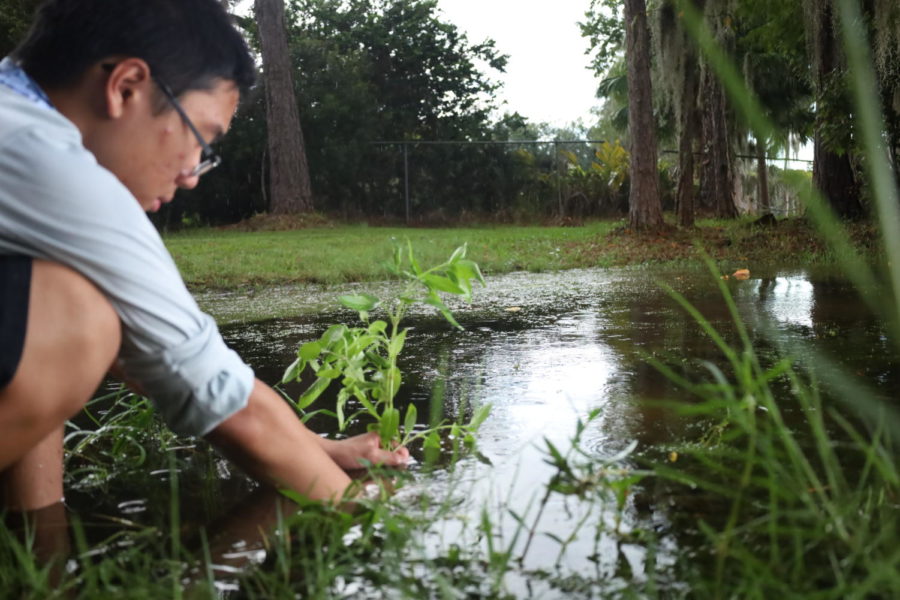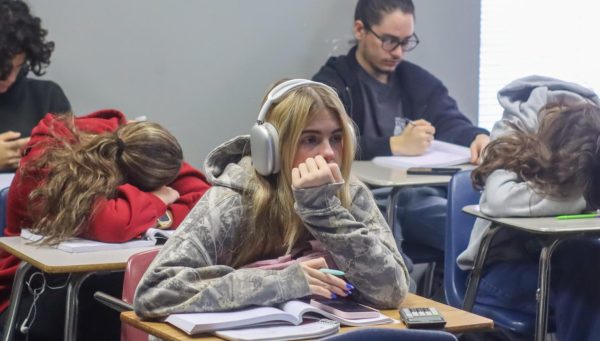No-swim zone
photo by Sarah Hinnant
Senior Andy Chan embeds a native plant along the shoreline of Lake Mills while volunteering with SERV to restore its shoreline. As part of Florida’s watershed management division, SERV recocomends that lakeside homeowners create “living shorelines” to prevent fertilizer pollution and algae bloom.
For a state known for its lakefront houses, clear springs and shining seas, Florida harbors a surprising amount of water management issues–80% of the state’s lakes and springs are currently unswimmable. The culprit? Algal bloom.
As Gov. Ron DeSantis and Charlie Crist prepare to face off for the title of Florida governor this upcoming November, stagnant lakes and contaminated springs have taken center stage as the state gradually fall victim to polluted runoff, a phenomenon that adds excess nitrogen and phosphorous into bodies of water, causing algae to grow at abnormal rates. Though DeSantis has made efforts to target harmful, blue-green algae, red tide, an annual algal bloom that plagues Florida’s west coast, still runs rampant. One of Florida’s largest sources of water supply, Lake Okeechobee, has faced strenuous pollution as a result of agricultural malpractice, causing red tide along its watershed and costing the state $23 billion in restoration efforts.
While algal bloom continues to pose a threat to local communities, students rise to the occasion, volunteering with environmental organizations to restore lakes, rivers and streams. According to Seminole Education and Restoration program coordinator Elizabeth Pearson, she sees hundreds of high school students at lake restoration events every year.
“It seems things are heading in the right direction, and that it’s a relatively current trend to be aware of the environment and want to protect it, but seeing [students], meeting them and finding out how passionate they are makes me very optimistic.”
Senior Andy Chan initially joined SERV to rack up volunteer hours for the Bright Futures scholarship, but after attending multiple lake restoration events, he realized how important his efforts actually were. He most recently visited Grace Lake, a shoreline that SERV had to revisit, as much of the living shoreline had been washed away.
“Seeing the lake region become greener and knowing that many other people were working towards the same goal made the project feel bigger,” Chan said. “It was a reminder that the events were not one-time things, and that it takes continuous efforts by groups of people to make a difference for the environment.”
To senior Connor Mclaughlin,, water quality is more than just a campaign prong. An avid fisher, he is painfully aware that algal blooms pose a substantial threat to his community. As Seminole County lays claim to the Econlockhatchee River, Lake Mills and Lake Pickett, its residents find themselves knee deep in scummy water.
“Fishing in Florida is like no other state because of the variety. You can go outside in your backyard and catch little bass and bluegill then drive 30 minutes to the coast and go catch redfish and snook all in a single morning,” Mclaughlin said. “The places and things we get to see won’t be here forever if they keep getting treated like they do.”
Biodiversity is exactly what Florida stands to lose; as excess algae infiltrate bodies of water, their oxygen levels quickly deplete, leaving other organisms like fish, bugs and sea grass struggling to compete for space and sustenance. This often results in eutrophication, where algae coats the surface of a lake or river, preventing organisms below it from receiving any sunlight. When searching for a spot to fish, Mclaughlin looks for clear, healthy water, something that will continue to grow scarce if algal blooms are left unchecked.
The pollution is really bad and it’s slowly killing the marine ecosystem,” Mclaughlin said. “I hope that [future] generations can grow up fishing in Florida the same way I did.”
As part of the Florida Watershed Management division, the SERV program specializes in preserving freshwater systems within Seminole County through shoreline restoration, during which volunteers will place native plants along the shores of vulnerable bodies of water to create a buffer against polluted runoff, improving its water quality and preventing potential algal blooms. These lakes are often surrounded by homeowners that use fertilizer, the most common runoff pollutant, to maintain their lawns. Pearson stresses that by educating homeowners on safe lawn maintenance practices and getting involved in organizations like SERV, lakeside communities could work together to preserve freshwater quality inland while indirectly reducing pollution along the coast.
“In just a few hours at a Saturday event, you can see how many plants you’ve planted, how many invasive species you’ve removed or how much litter you’ve cleaned up,” Pearson said. “People can make a big difference in a small amount of time.”
Your donation will support the student journalists of Hagerty High School. Your contribution helps us publish six issues of the BluePrint and cover our annual website hosting costs. Thank you so much!







